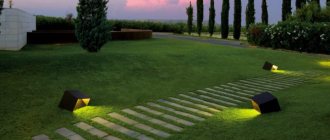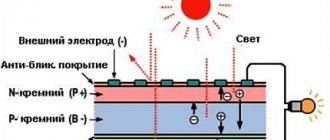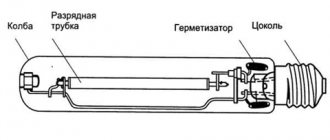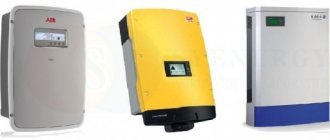The local area, paths, lawns, and gardens need good lighting. In order to see the yard and driveways in the evening, it is not necessary to create a miniature Las Vegas by connecting electric lamps.
You can organize soft street lighting using solar batteries - this is not difficult to do, and the benefits of such a solution are obvious. Lamps bring practical benefits, help save energy resources and improve the decorative appearance of the garden. Still in doubt?
We invite you to learn more about solar-powered lanterns. In the article we examined the design, operating principle, types, advantages and disadvantages of such lamps. In addition, we have prepared a review of the best models and options for their placement on a personal plot.
Why install lamps using photocells?
Solar-powered lighting devices have their own advantages and differ from traditional light sources:
- Autonomy. There is no need to connect to electrical networks with traditional wires, control panels, and fuses.
- Energy independence. Whenever the power supply is turned off, your area will always be lit, and your electricity bills will not increase.
- Absolute automation. All light sources are equipped with solar panels and can be charged, turned on and off without human presence.
- Easy installation. There is no need to call electrical specialists. The owner can do all the work on placement, installation, and connection with his own hands with a minimum of expended energy and effort. If the location of the lamp for any reason does not suit you, you can always easily move it to another place.
- Easy to maintain. They do not require special knowledge to maintain the lamps in working condition.
All equipment costs occur at the initial stage. The difference in the cost of high-quality electric lamps and solar-powered street lighting is not very noticeable. All the difference can be noticed only during operation. In the future, solar equipment will definitely pay for itself and will provide a net profit, while for stationary electric lighting it is necessary to pay bills from electricity suppliers every month.
We recommend reading: can a solar battery be used for a summer residence, what additional devices are needed for this and how to choose them correctly.
Advantages and disadvantages of solar cells
Among the advantages, environmental friendliness should be put in first place. Other benefits include:
- economical - no need to pay electricity bills;
- luminaires with photocells are easy to install;
- for street lighting there is no need to lay cables in the ground;
- works without electricity, which means it does not depend on problems in the electrical network;
- It is possible to illuminate remote corners of a summer cottage where it is impossible to lay wires.
Among the disadvantages are the following:
- high cost of solar modules;
- the need for large space to accommodate modules;
- Not all models can operate on battery power for a long time without charging.
Whether or not to install solar panels at your dacha is everyone’s decision. Not all areas have electricity, and then power from the sun becomes a real salvation. But even if the inside of the house is fully supplied with electricity, then for external lighting you can choose several original lamps with photocells.
Operating principle
The main element in such street lamps is photocells assembled into a single solar panel. When the photopanel is brightly illuminated by the sun, it begins to generate electric current. In principle, the lamp will start working now. But why would he work during the day? Therefore, the circuit is supplemented with a battery.
During the day, the built-in light sensor redirects energy through a diode to the battery. The diode, as it were, locks the battery and does not allow it to work during the daytime.
With the onset of darkness, the same light sensor will no longer cut off the power supply to the LEDs and opens the VD transistor. Chain: battery → emitter → transistor collector → LED panel starts working.
At dawn, as soon as the first rays of the sun hit the light sensor, the illuminator's power circuit is turned off and the battery charging circuit is turned on.
Of course, this is a simplified description of the operating principle of solar-powered street lighting devices. Industrial designs for lighting using photo panels are equipped with a complex automation system. And the batteries are supplemented with inverters that convert direct voltage from solar panels into alternating voltage to turn on lighting devices.
The duration of their operation depends on how brightly the street lamps work. When the battery is discharged, the system itself will automatically turn off the power to the lamp. This is especially true in winter, when the lamps simply do not have enough daylight to recharge the batteries.
Naturally, the time at which street lights turn on depends on the time of year. In winter they turn on closer to 18-00 pm, and in summer at 2100–2200 pm.
Another important point is the photocells themselves.
As a rule, you can find photo panels made on the basis of monocrystalline silicon on sale. They showed better reliability and durability parameters than those based on polycrystalline photocells.
Features of the design and operation of lamps
There are many types of solar-powered lighting devices, but their design and operating principle of light panels are approximately the same. Solar energy is accumulated using special batteries and accumulators.
When power is applied to a semiconductor LED, it emits visible light. The LED control system consists of a light sensor and a microcircuit.
Due to the peculiarities of their design, the lamps can operate in both summer and autumn. Depending on the season and the degree of illumination, they turn on from approximately 6 to 9-10 pm (+)
The intensity of the lantern's glow depends on the voltage. When the battery is low, the control system turns off the light. It is turned on using a special photocell, the function of which is to convert solar energy into electrical energy.
Installing powerful models is not always convenient. In many cases, it is better to select low-power lamps and install them closer to the ground. This will allow you to save on equipment, and the quality of path lighting will not decrease
When choosing lamps, you should take into account not only the technical characteristics of the devices themselves, but also the climatic features of the area. Batteries cannot withstand frost, so in regions where severe winters are possible, the lanterns are dismantled in late autumn and returned to their place only in the spring.
In late autumn, when daylight hours are short and the weather is often cloudy, the batteries of solar-powered lanterns are rarely fully charged. However, the energy is enough for several hours of illumination in the evening.
Most models have photocells made from silicon. This is an important nuance, because... devices based on monocrystalline silicon are more reliable and durable than models with polycrystalline photocells.
They also pay attention to the type and quality of glass. The best choice is flashlights with polycrystalline photocells and tempered glass.
Complete set of solar panels
Despite the apparent simplicity and elegance, solar lighting devices are quite complex equipment, which consists of:
- Cases. The configuration and material from which it is made can vary - from metal to wood. The installation method is also very different - from wall-mounted and suspended to special supports for installation on the ground.
- Light source. As a rule, LED lamps are used as a light source;
- Ceiling lamp. Required element. Performs two functions. This is both a lamp protection and a lamp diffuser.
- Accumulator battery. An indispensable component of the power supply circuit of a street lamp. In the evening and at night, it transfers the electricity accumulated during daylight hours to the lamp.
- Solar module. Needed as a converter of solar energy into electrical energy.
- Light sensor. Reacts to changes in day and night, which allows the street lamp to turn on and off automatically.
In addition, stabilizers, diodes, and inductors take part in the operation of the lamp. They all work to ensure the necessary parameters for the smooth operation of all street lighting.
If there is no need for constant service of the lamp at night, the control circuit can be supplemented with a motion sensor. Thus, the street lamp will turn on exactly when a person appears in its area.
What to look for when choosing
What type of power supply for the street lamp do you have? Solar Electric
Before purchasing a flashlight, you need to determine what functions it will perform and what requirements apply to the lighting device.
Particular attention should be paid to the following properties and parameters:
- Dimensions – for installation near the house this does not matter. And to use it as a portable light source, you need to buy a small flashlight.
- Housing type - users recommend buying lamps made of lightweight aluminum. It is durable enough for daily use and carrying around the site if necessary. Aluminum is not afraid of frost and (unlike plastic) will not burst.
- Battery capacity – it is believed that the more, the better. However, a battery that is too capacious will not have time to fully charge. Especially if you live in a region where there are no long sunny days. As a result, the money overpaid for a large battery will be wasted.
- Solar panel size – the larger the area, the faster recharging will occur.
When purchasing, you should also look at the manufacturer’s warranty period, study additional features: moisture protection, resistance to dirt and dust, additional connectors for connecting power supplies, is there a motion sensor included.
What are the operating modes:
- “Night light” – shines constantly, but not at full power. When the motion sensor detects that someone is passing nearby, it turns on the flashlight at full power.
- “Continuous lighting” – works at full power until the power runs out or the sun rises.
- “Off, reacts to movement” – the flashlight starts working only when it detects activity, the rest of the time it does not light up.
Varieties
There are many types of street lamps powered by solar panels. Among them are the main designs:
- wall;
- park;
- lawn;
- decorative.
When choosing the type of lamp, it is important to take into account, in addition to the technical characteristics of the devices themselves, the climatic conditions of the area where they will be used.
We must remember that autonomous solar-powered lighting cannot do without batteries. In those regions where severe frosts are quite possible, it is necessary for this period either to dismantle the lamps until spring, or to ensure their operation in such a way that the operation of the storage elements is protected from the influence of low temperatures.
In all other respects, such lighting can be used anywhere in a summer cottage and country houses. Moreover, the light elements themselves can be an excellent addition to the design of the landscape.
Of course, you must always remember that these light sources use energy from the sun. This means they need to be placed in such a way that they receive as much sunlight as possible. If the solar cells are directly exposed to the sun's rays at least 12 hours a day, reliable operation of the lanterns will be ensured.
And then, in principle, any modification of a street lighting device will become useful and functional.
Photo ideas
Among the existing models of solar-powered lighting devices, many of them are widely used for individual design of the territory and creating an atmosphere of comfort on the site. Here we will look at some of the most interesting ideas for installing street lights.
Rice. 7: photo idea for highlighting a flower bed
Rice. 8: Yard Lighting
Rice. 9: Lighting the path with built-in lamps
Rice. 10: Sidewalk lighting
Rice. 11: Parking arrangements
Rice. 12: Garden lighting
Rice. 13. Sidewalk lighting
Main selection criteria
External equipment and solar lighting fixtures themselves can be divided into two types:
- lamps for the garden and adjacent areas, which mainly serve for decoration and illuminate a small area of the area around them with their light;
- outdoor LED lamps, which are primarily needed for the best possible illumination of the entire local area. And only then can they be used as landscape lighting.
Outwardly, they are quite similar, but the tasks they perform are completely different.
Street lighting requires more reliable and powerful lighting devices.
But now we have reached the cost stage.
For private summer cottages, inexpensive models of lighting devices powered by cheap batteries were used. They used up their resources quite quickly.
Street lighting on poles requires a different approach. More powerful nickel-cadmium batteries are required that can last for a long time. Other light bulbs are also needed. LED lamps have a lifespan of 30–60 thousand hours.
The durability of the entire complex of street lamps is also affected by the quality of the solar panels themselves, which must have protection against mechanical damage with a long service life.
If you create a powerful (10–15 W) lamp with a motion sensor, this will be enough to comfortably illuminate the space around the house.
And only in this case you get the opportunity to get the highest quality lighting of the entire local area.
Top models
All models of street lamps were tested in Russia and some users left reviews about electrical appliances.
Novotech Solar black
The solar panel wall lantern is designed to be installed on horizontal or vertical surfaces. The shape is in the form of a rectangular panel, the mounting bracket is attached to the body with wings to adjust the position of the lamp.
Production characteristics:
- Novotech (Hungary).
- Collection – Solar.
- Height: 151 mm (15.1 cm).
- Width: 115 mm (11.5 cm).
- Length: 163 mm (16.3 cm).
Specifications:
- The power of the lamp unit is 12.4 W.
- Total power – 12.4 W.
- Color – black and white.
- The material of the lampshades and fittings is plastic.
The warranty period is 12 months. The average price is 3,400 rubles.
Ever Brite Solar Motion
Black plastic street lamp for home and garden. There is a motion sensor, holes are made in the case for mounting on the wall.
Specifications:
- The estimated lighting area is 10 m².
- Dust and moisture protection degree – IP55.
- Number of LEDs – 4.
- Lamp color – black
- Light flux – 120 lm.
- Voltage – 12 V.
Cons: due to the use of plastic, the model cannot be left in the sun for a long time - it may fail due to overheating of the batteries.
Warranty – 12 months. The average price is 400 rubles.
LIKES 30 LED
A small flashlight with a motion sensor and a high-capacity battery. Assembled in a compact case, it will work for a long time when installed near the house or on the site.
Specifications:
- Number of lamps – 30.
- Maximum lamp power is 6 W.
- The lampshade material is plastic (ABS).
- Battery parameters – 3.7 V, 1200 mAh.
- Battery type – lithium-ion.
- Black color.
- Case dimensions: 124 x 96 x 68 mm.
Pros: small size, can be carried with you. Hanging on a horizontal surface takes 5-10 minutes. Shines brightly. The case is protected from moisture.
We buy a solar lamp
On the modern market, the choice of lamps for working in the local area is quite large. It’s not difficult to get confused by such diversity.
We will tell you what you should pay attention to first.
Power
The area of the illuminated space depends on how powerful the light source is. Modern realities are such that the buyer already knows the advantages of LED lamps. For models that will be used to illuminate roads or decorate gardens, powerful models are not needed.
In order to better navigate people in cars in suburban areas, there are more powerful models.
To make it easier to navigate among the variety of light bulbs, we have collected all the light bulbs in one table:
- LED;
- luminescent;
- incandescent lamps.
And we grouped them by power:
Protection class
Since it is assumed that our lamps will be used outdoors, the “Protection Class” parameter shows how protected our lamp is from the influences of the external environment.
The IP class characteristics of the device are important to us.
The table clearly shows that for street lamps the optimal protection class is IP44, but it can be higher, but it will cost more.
But the table only helps to select the right device with the right protection class. But, generally speaking, you must first focus on the climatic features of the area where this lantern will be installed.
Housing material
This is where it is difficult to give advice. No, of course, for outdoor lighting of large areas to last for a long time, strong and durable materials are needed.
And if these are decorative lamps, then their body can be made of anything - metal, plastic, glass and even wood. The solar panels themselves are more important here. They must be of high quality.
Types of lamps and installation methods
As already mentioned, there is a wide variety of lamps.
Based on type and method of installation, they are divided into:
- Ground - mainly used for designing garden paths, lighting, as a decoration element or landmark. The length and height of the legs can be adjusted to your liking.
- Wall-mounted - highlight a section of the wall very favorably. It can also be used as an element of illumination of the adjacent area.
- Hanging - can be hung anywhere in the local area. Mount either on chains, or on a cable, etc.
- Built-in — go deeper into the structural element. Serve as lighting for garden paths or parking areas.
Places of use
Depending on the location and tasks performed, street lighting devices are divided into the following categories:
- park lanterns - provide light to large areas, have a high leg with a stand at the bottom.
- street lamps - designed to illuminate streets, suspended or mounted on poles and supports, structural elements of buildings, etc.
- for illuminating gazebos, terraces, verandas and other semi-open buildings located on the street.
- garden lanterns for illuminating paths are not only sidewalk indicators, but also create sufficient visibility to navigate them in the dark.
- decorative - intended for decorating house and garden areas.
Advantages and disadvantages
The main advantages of solar cell devices for outdoor lighting are:
- Absolute autonomy - any light source has its own power plant - solar panels;
- Mobility - since lighting devices can also serve as decoration for the local area, they could easily be removed and moved to another place;
- Possibility of independent installation work - the entire range of work on installing and connecting lighting fixtures can be performed independently without the help of professional electricians.
- Small size - there is no need for special equipment to transport equipment;
- Easy to set up - the timing of switching on and off the lamps is automatic;
- Electrical safety - all elements that ensure operation can be placed in the same housing with the lamp, which prevents electric shock to a person;
- The possibility of using such lamps as an element of decor in the local area.
But there are also disadvantages:
- The efficient operation of lamps is greatly influenced by external factors such as weather. On cloudy days, the efficiency of recharging external electricity storage devices is greatly reduced;
- The operating time largely depends on the quality and capacity of the batteries. And the drives themselves lose their capacity over time and fail;
- Dependence on ambient temperature. At sub-zero ambient temperatures, long-term battery operation is impossible;
- Due to their mobility, small lamps can be stolen by intruders;
- The need to keep lighting fixtures and solar panel clean. Dirt and dust greatly reduce work efficiency.
Type of silicon in lamps
The durability of the luminaire depends on the type of silicon used:
- monocrystalline silicon is the most reliable, plus it is additionally covered with an oxide film. Resistant to climatic and chemical influences well. Minus – high price;
- multicrystalline is average in terms of practicality. It will last several years, but no more;
- polycrystalline – the cheapest and short-lived. Already in the second or third season, you will notice a drop in the glow power and operating time.
Where can I buy
You can purchase solar panels either in a specialized store or online in an online store. In the second case, the budget option for purchasing products on the Aliexpress website deserves special attention. For some panels there is an option for shipment from a warehouse in the Russian Federation; they can be received as quickly as possible; to do this, when ordering, select “Delivery from the Russian Federation”:
| LED Solar Pendant Lamp | LED lamp with solar battery and motion sensor | Solar LED street lamp |
| Dokio Portable Solar Panel 18V 200W | Outdoor LED solar lamps, with sensor, 270 | Solar Powered Outdoor Wall Lamp |
The best ground lights
To create the effect of a courtyard area, ground-based lighting devices are used. They are necessary to provide illumination to entrance areas, gazebos, paths, and alleys. Experts weighed in on some interesting options.
Novotech Solar 357413
Hungarian designers surprised with their bright solution. An unusual model serves to illuminate the garden area. The motion sensor commands the simultaneous activation of 28 LED bulbs. The lamp operates at a distance of 10 m, the detection angle is 120 degrees. The operating temperature range is quite wide, it lies in the range from minus 20 to plus 40 degrees Celsius. The power of the luminous flux is sufficient to provide light to an area of at least 5 square meters. A high degree of protection against dust and moisture, as evidenced by the IP54 number in the lamp passport. The manufacturer guarantees reliable operation, the warranty period is 2 years. The total power is 2.5 W. Thanks to the bright glow, the presence of a touch switch, and a high degree of reliability, the model turned out to be out of competition compared to other samples. Many buyers are not afraid even of the high cost. The lamp justifies itself.
Novotech Solar 357413
Advantages:
- originality;
- reliability;
- brightness.
Flaws:
- high price
Globo Lighting Solar 33961-4
The Austrian manufacturers were once again pleased. The ground model has a design in the Art Nouveau style and can perfectly illuminate the garden and park area in a country residence. There are spikes that allow for hassle-free installation. The voltage of the solar panels is 3.2 V, four LED lamps have a power of 0.06 W each. The cylindrical body is made of stainless steel and has a built-in plastic transparent lampshade. This entire facility can illuminate an area of up to 1 square meter. m. High-quality materials, stylish appearance at an affordable price allow us to assign a high rating to the product. There is such a minus: sometimes there is not enough charge until the morning.
Globo Lighting Solar 33961-4
Advantages:
- inexpensive;
- made from quality materials;
- capable of illuminating a large area;
- impressively decorated.
Flaws:
- Has a small battery capacity.
Novotech Fuoco 357991
The development of Hungarian designers has taken its rightful place in the Russian market. The device with a high degree of protection (IP65) combines black fittings and a white plastic lampshade. The model is equipped with an LED light bulb, its power is 1 W. The body with a diameter of 12 cm is located at a height of 76.3 cm. The insufficient brightness of the lighting does not allow it to take the lead, so the lamp lags slightly behind the leaders. The package includes only 1 lamp and a solar battery. The manufacturer provides a two-year warranty. Many people like the original design, and the affordable price plays an important role; the high degree of dust and moisture protection also speaks in favor of this design. But a modest luminous flux pulls down.
Novotech Fuoco 357991
Advantages:
- high degree of protection;
- elegance;
- affordable price;
- sustainability.
Flaws:
- insufficient light flux.
System calculation
If it is decided to make solar-powered street lighting reliable - with batteries, first of all, you need to replace all the lamps and lanterns with LED ones that operate on 12 V. Why is this so? Because the batteries produce constant voltage, and some of them are just 12 V. You can also power 220 V lamps from this system, but you will also need an inverter that converts 12 V to 220 V. And this is an additional expense. Therefore, it is advisable to choose just such lamps, lanterns and lamps.
Composition of a street lighting system with 220 V lamps: an inverter is also needed
Finding the power and number of solar panels
In order for the system to be reliable, it is necessary to calculate the power of the solar panels and the capacity of the batteries that will provide it. The calculation procedure is as follows:
- Find the power of the entire load (calculate the power of all lamps).
- Calculate the longest period of lighting operation.
- Based on these data, calculate how much energy per day is needed to operate the equipment (multiply the found numbers).
- Find the lowest insolation level of the year (monthly average) in your region. In Russia this is usually the month of December.
The more sunny days a year in a region, the more profitable the transition to solar energy
- Find out the performance of solar panels in your region. To do this, you need to multiply the found level of insolation by the average efficiency of solar panels (take the efficiency of 17%, that is, you need to multiply by 0.17). As a result, you will find out what is the minimum amount of energy a square meter of battery will produce in your region.
- Based on the figure found, calculate the area of solar panels required to produce the required amount of energy. To do this, divide the figure found in point 3 by the minimum productivity per square meter of solar panels (calculation result in point 5).
Next, it’s a matter of choosing solar panels. You choose, find out their area, count the number of pieces. Their total area should be no less than that of ours. It is even advisable to have a reserve, since there are always periods with worse characteristics than average.
Batteries
It is also necessary to calculate the capacity of the batteries, which should provide energy to the lamps in case of prolonged bad weather. Here you will also need weather forecaster data. But the longest period of bad weather will be needed. Also, for the calculation, you need daily energy consumption to maintain performance (point 3 in the previous section).
The calculation is simple. We multiply the daily consumption by the number of days of bad weather. We get the reserve that the batteries should provide. Next, you need to look for batteries with suitable characteristics. You just need to take it with a 30-40% capacity reserve, since a full discharge shortens the life of the batteries. Therefore, it is undesirable to discharge them too much.
Batteries for solar panels - available in different sizes and parameters
Sometimes manufacturers indicate only the possible energy reserve, which is expressed in A/h (ampere hours). This value can be converted into W/hours if multiplied by the operating voltage of the battery (indicated in the specifications). For example, Ventura GP 12-26 battery - voltage 12 V, capacity 26 Ah. You can convert it to watt hours like this: 12 V * 26 A*h = 312 Wh.
Controller selection
Let's start by figuring out why a controller is needed in this system. If you connect the solar panel directly to the battery, it will begin to charge when electricity is supplied. When the maximum charge voltage is reached (depending on the type of battery and its temperature), it must be turned off. If there is no controller, this must be done manually. If you turn it off at the wrong time, this will lead to boiling of the electrolyte, shortening the battery life. So you need a controller.
Solar controllers come in three types:
- ONN/OFF. Monitors the amount of charge. When the maximum voltage is reached (for 12 Volt batteries this is 17 V), it will simply turn off the charge source. This controller option is the cheapest, but it has a significant drawback. In fact, when the maximum voltage is reached, the battery is far from fully charged, but only 90%. Constant undercharging leads to a reduction in its service life.
- PWM controller. Once the maximum voltage is reached, it does not disconnect the battery. Using a conversion, it lowers the voltage to the required value and charges the battery for another couple of hours.
- MPPT controller. Like PWM, it fully charges the battery, but does it faster (under equal conditions) by using all the power of the solar battery.
Selecting a controller based on its capabilities
In fact, choosing a solar panel controller is simple: the best option is MPPT, and PWM is a good option. In extreme cases, ONN/OFF is also suitable, but it is better not to use it.
When choosing a controller, you should also pay attention to the fact that it can adjust the system parameters depending on the temperature of the battery. To do this, it must have a thermal sensor. It can be built-in or remote. Remote models show more correct data, so give preference to such models.
System calculation example
To make the calculation of a solar lighting system on the street clearer, we will give an example. It is necessary to provide energy to lamps with a total power of 10 W, voltage of 12 V. The longest operating period is 14 hours, the lowest level of insolation in the year is 1.21 kWh/m2/day. The calculation is as follows:
- We find the required amount of energy per day: 10 W * 14 hours = 140 Wh per day.
- The performance of solar panels in the worst month of the year is 1.21 kWh/m2/day * 0.17 = 0.2057 kW per day. That is, a square meter of battery with these parameters will produce about 200 Watts of electricity per day. So you can take batteries exactly with a meter area - there will just be some reserve for the worst conditions.
The choice of parameters and components depends on the operating conditions and the required performance
- Determine the required battery capacity. Let the longest period of bad weather be 8 days. Then energy must be stored: 140 Wh per day * 8 days = 1120 Wh. If we take the minimum, the battery should have a capacity of 100 Ah, but this will not always be enough. Specifically, during prolonged bad weather in autumn or in winter in cold and cloudy weather. Therefore, it is better to take a 150 Ah or even 200 Ah battery.
When selecting equipment, you can even look at larger battery ratings and greater performance or area of the solar system. Sometimes, paradoxically, more productive equipment costs less. Also, it’s not a fact that after a while you won’t want to add load to the system. So the supply will come in handy.
Price issue
Solar-powered street lighting in this design is not a cheap undertaking. For example, for the calculation example given, you can select the following equipment:
- 250W polycrystalline solar cell manufactured by Chinaland Solar Energy. Cost 15160 rubles.
- Tracer MPPT Charge Controller (100V), 20A, 12/24V, manufactured by Beijing Epsolar Technology. 8640 rubles.
- Gel battery GX12-150, 150 Ah, GEL, manufactured by Delta - 21,230 rubles or GX12-200, 200 Ah GEL costs 26,160 rubles.
In total, the equipment costs a little more than 45 thousand rubles. But you will also need brackets for installing a solar battery (2-3 thousand rubles), sealed connectors and special wires for solar power (this is another 1-2 thousand rubles). The idea is really not cheap.
To completely convert street lighting to solar energy, a large number of batteries are required...
How can you reduce costs? Purchase domestically produced equipment directly from manufacturers. For example, batteries can be purchased from Zelenograd Telecom STV, inverters and controllers from MAP Micro Art LLC. Also, instead of special batteries, they buy 12 V car batteries; they do not have the same characteristics, they need to be changed more often, but they are much cheaper. Even taking into account the fact that they need to be changed every 2-3 years. Under such conditions, solar-powered street lighting can cost half as much.











